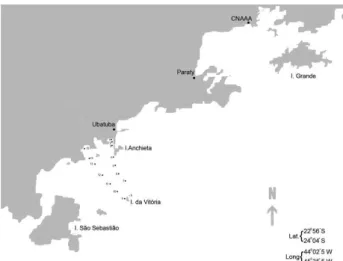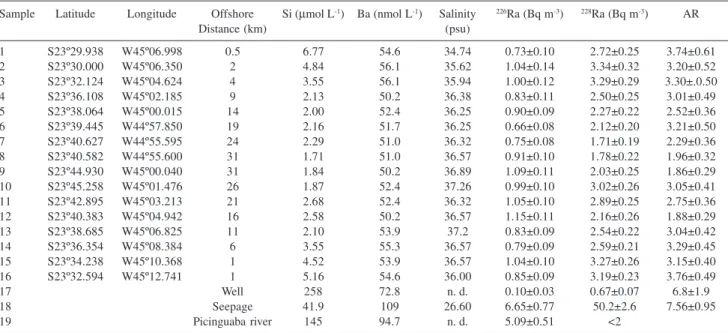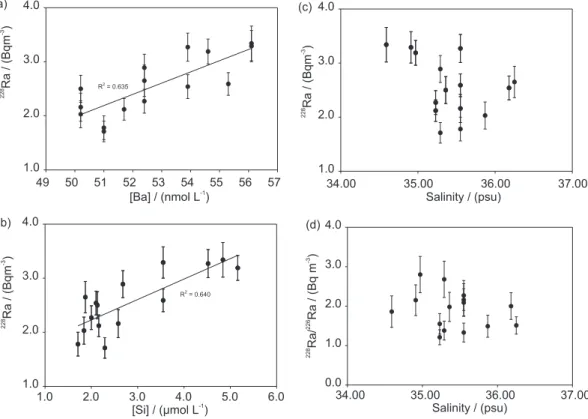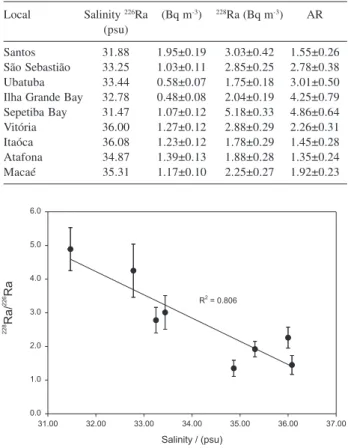Printed in Brazil - ©2006 Sociedade Brasileira de Química 0103 - 5053 $6.00+0.00
A
r
ti
c
le
* e-mail: jmgodoy@ird.gov.br
228
Ra and
226Ra in Coastal Seawater Samples from the Ubatuba Region
-Brazilian Southeastern Coastal Region
José Marcus Godoy,*,a,b Zenildo Lara de Carvalho,a Flávio da Costa Fernandes,c Olga M. Danelon,c Maria Luiza D. P. Godoy,a Ana Cristina M. Ferreiraa and Luiz Alfredo Roldão a
a
Instituto de Radioproteção e Dosimetria, Comissão de Energia Nuclear, CP 37750, Barra da Tijuca, 22643-970 Rio de Janeiro-RJ, Brazil
b
Departamento de Química, Pontifícia Universidade Católica do Rio de Janeiro, Rua Marquês de São Vicente 225, Gávea, 22453-900 Rio de Janeiro-RJ, Brazil
c
Instituto de Estudos do Mar Almirante Paulo Moreira, Marinha do Brasil, Rua Kioto 253, 28930-000 Arraial do Cabo-Rio de Janeiro-RJ, Brazil
O presente trabalho apresenta os resultados de 226Ra e 228Ra obtidos durante o 4o experimento
de intercomparação referente à descarga submarina de água subterrânea (Submarine Groundwater Discharge, SGD) realizado em Ubatuba (SP), em novembro/2003. Este experimento visava testar, em um sistema de rochas cristalinas fraturadas, as diferentes metodologias existentes de determinação da SDG. Embora com objetivo distinto, decidiu-se participar deste experimento de modo a verificar se os isótopos de rádio poderiam ser empregados no estudo de mistura de águas na região e, também, testar a capacidade analítica do laboratório, visando uma futura validação de modelos de dispersão marinha para o local de instalação dos reatores nucleares de Angra dos Reis, distantes apenas setenta quilômetros da região do experimento. Além das concentrações de 228Ra e 226Ra, resultados de salinidade, bário e sílica também são apresentados
e suas relações com a concentração de 228Ra são discutidas.
The present work reports 228Ra and 226Ra results obtained during the 4th Submarine Groundwater
Discharge (SGD) intercomparison experiment realized in Ubatuba, November 2003, aiming to test the methodologies on a fractured crystalline rocks system. Although with distinct objectives, it was decided to participate in this experiment in order to verify if radium isotopes could be used to determine water mixing rates in this region and to test the laboratory capability to perform, later on, a marine dispersion model validation at Angra dos Reis reactor site, located nearby. The results show that the SGD model constrains seems to be valid, at least for a distance of 20 km offshore, that corresponds to the distance between the reactor site and Ilha Grande, a 193-km2
island existing at this site and probably an additional SGD source. Salinity, barium and silica results are also reported and their relation to 228Ra concentrations is discussed.
Keywords:228Ra, 226Ra, seawater, submarine groundwater discharge, Brazil
Introduction
The Angra dos Reis nuclear power plant site is located 130 km south from Rio de Janeiro city. There are two pressured water reactors in operation at the site: the first one started operation in 1985 and has a nominal capacity of 660 MWe and the second one is a 1300 MWe unit and started its operation in 2000. Seawater is used as cooling water for both units; the cooling water is pumped from
Itaorna Bay and discharged into Piraquara de Fora Bay, together with the liquid effluents from the two NPP.
The dispersion of discharged radionuclides was modeled by Fernandes et al.1 in order to allow the assessment of the
committed dose incurred by the local population in case of normal operation and accidents. The results obtained suggested that conservative radionuclides released, such as 137Cs and 3H, are efficiently exported to the open ocean.
its potential application was restricted to the Piraquara de Fora Bay. For a longer distance an alternative was needed. With the development of the research related to the importance of the submarine groundwater discharge (SGD) as an relevant source of substances to the coastal region and, in particular, with the consequent use of radium isotopes for the determination of coastal mixing rates,2 it was decided to investigate its potential
application as a way to validate the dispersion model. An updated review of SGD in seawater was published by Burnett et al.3 In order to compare the different SGD
assessment methodologies the Intergovernmental Oceanographic Commission of UNESCO (IOC), the International Hydrological Program (IHP) and the International Atomic Energy Agency (IAEA) are sponsoring intercomparison experiments at different locations around the world. The previous SGD intercomparison experiments were performed in Gulf of Mexico, Florida (2000); Cockburn Sound, western Australia (2000) and eastern Long Island, New York (2002). The experimental setup and results of the Gulf of Mexico SGD intercomparison experiment are found in Biogeochemistry volume 66, number 1-2, November 2003, a special issue dealing with it. The Ubatuba experiment was realized in November 2003 and aimed to test the methodologies on a fractured crystalline rocks system. The first experiments on SGD at the Ubatuba coast were performed by Oliveira et al.4 and indicated a significant
inflow of several cm per day.
Determining coastal mixing rates using radium isotopes 2
The change in concentration or activity (A) with time (t) as a function of distance offshore (x) for a conservative, non reactive tracer may be expressed as a balance of advection and diffusion:
(1)
where Κh is the eddy diffusion coefficient and ω is the advective velocity. Lateral effects are ignored in this one-dimensional approximation. If Kh and ω are constant, the offshore distribution of a conservative tracer may be used to determine the relative importance of these processes in moving the signal offshore (advection) and diluting if (diffusion). If the offshore distribution is dominated by diffusion with constant Kh, a plot of activity vs. distance will be a straight line connecting the end members. Offshore advection will cause positive curvature and onshore advection will cause negative curvature to this plot. This model assumes there is no additional input of the tracer beyond the nearshore. The existence of a termocline isolate the surface water from
inputs from below. Once added to nearshore waters, the two long-lived radium isotopes, 226Ra (t
1/2 = 1620 years) and 228Ra
(t1/2 = 5.7 years), are conservative tracers.
For the short-lived radium isotopes, 223Ra (t
1/2 = 11.3
days) and 224Ra (t
1/2 = 3.66 days), a decay term must be
included in the equation describing their distributions. Equation (2) describes the distribution of the activity of a radioactive tracer with decay constant λ in the same context:
(2)
If net advection can be neglected, this reduces to:
(3)
In this case, the boundary conditions are:
A = Ao at x = 0
A → 0 as x →∞
If Kh is constant and the system is in steady state:
(4)
where Ax is the activity at distance x from the coast, Ao is the activity at distance 0 from the coast and λ is the decay constant.
A plot of ln223Ra or ln224Ra as a function of distance
from the coast may be used to estimate Kh, if the exchange is dominated by eddy diffusion rather than advection and if the system is in steady state:
(5)
In this case, the slope is .
Therefore, using long-lived radium isotopes in coastal waters it is possible to verify which mixing mechanics (diffusion and advection) are present. Where the exchange is dominated by diffusion, applying short-lived radium isotopes it is possible to determine the eddy diffusion coefficient.
This methodology was successful applied to Yeoja Bay, morphologically similar to Ribeira Bay, including the presence of several islands inside and nearby the bay outlet, in order to estimate nutrient inputs to.5 Although with
dos Reis reactor site, located only 70 km from Ubatuba. At Angra dos Reis reactor site, two others radium sources have to be taken into account at Angra dos Reis reactor site, Ilha Grande SGD and the current flowing though the Ilha Grande/Angra dos Reis channel. But, despite any morphological difference between Ubatuba and Ribeira bay, the radium contribution from the shoreline should be such that it could be differentiated from the open sea end-member, and this can be evaluated with the Ubatuba SGD experiment due to the geological similarity between both locals (Figure 1), with the presence of granites and migmatites of mountain chains (Serra do Mar), which reaches the shore throughout almost all the study area, and limits the extension of the drainage systems and of the Quaternary coastal plains.
In the future, in order to evaluate the relative influence of these two other sources, 2-3 transects at Ribeira bay surroundings will be performed, one of them, from Mambucaba beach, crossing the bay, in direction to open sea through the channel between Ponta de Juatinga and Ilha Grande. Since multiple tracers as short and long-lived radium isotopes, barium, silica and salinity will be used it should be possible to evaluate their relative contributions.5
Experimental
The Ubatuba SGD experiment was performed during the period 16-22 November 2003, at the same region described by Oliveira et al.4 Samples of surface ocean
water were obtained during two cruises, the first one realized on 18th November from Flamengo Bay to Vitoria
Island (31 km offshore) and, next day, the second one from Vitoria Island to Fortaleza Bay (Figure 1 and 2). The distance between each sampling station was about 5 km and a total of 16 samples were taken. The R/V
Albacora (Instituto de Oceanografia, Universidade de São Paulo) was used on both cruises and each sampling station localization was recorded by an on-board GPS, the distances to the coast were calculated based on these records. At each sample station 100 L seawater was taken and pumped through on-line filter cartridge (2 µm pre-filter and 0.45 µm filter) followed by a column of manganese coated acrylic fiber (Mn fiber), to quantitatively remove radium.6 The Mn fibers were
leached with HCl and hydroxylamine hydrochloride was added in order to produce a clear solution. Radium was co-precipitated with BaSO4 and 228Ra and 226Ra
determined by gross beta and alpha counting as described by Godoy et al.7 The detection limit achieved was 0.02
and 0.3 Bq m-3 for 226Ra and 228Ra, respectively, and the
relative measurement error ranges were between 5-10%. Additionally, a seepage meter (10 L), an artesian well and Picinguaba river (20 L) water sample were collected, in order to obtain the 228Ra/226Ra activity ratio signature
of the surface and groundwater end members. Seawater samples for 228Ra and 226Ra were also collected under
the MOMAM program during the year 2003,8 in order
to determine its variability across the Brazilian Southeastern coast.
At each sampling site, a 100 mL sample was taken and kept frozen for the determination of salinity, silica and barium. Barium and silica were determined by inductively coupled plasma atomic emission spectrometry (Perkin-Elmer ICP-AES Optima 2000 DV), salinity by titulation with silver nitrate.
Results and Discussion
Figure 2. Detail of the Ubatuba nautical chart with the seawater sam-pling points.
The obtained results are shown in Table 1. The artesian well was located on the granite hills close to the Marine Laboratory, due to its very low radium concentration, the contribution of groundwater coming from these mountains to the radium content of coastal water discharged at this region seems to be not relevant. Similarly, Picinguaba river has crystalline waters with; also, low radium content, and cannot be taken as a relevant radium source for the coastal seawater. On the other hand, the 228Ra content on the seepage water was
15-20 times higher than that observed seawater concentrations. The 228Ra/226Ra activity ratio (AR) in the seepage and the
artesian well water are similar to the 232Th/238U AR observed
in monazite samples taken at the Rio de Janeiro coast,9
therefore, it is valid to suppose that the monazite leaching by groundwater moving to the beach is the reason of the high radium concentration observed in the seepage water sample, and this groundwater can be taken as the coastal end member. Figure 3 shows the 228Ra and 226Ra concentrations as a
function of distance offshore. For 226Ra there is not a clear
function of the distance offshore as observed for 228Ra. For 228Ra the data within 20 km of the coast fit a line of (-0.0714)
Bq m-3 km-1 having R2 = 0.889, there is a break in the slope at
21 km and another at 26 km but only the first break is observed for the 228Ra/226Ra ratio (Figure 4). These two breaks could be
due to the existence of offshore groundwater discharge. A break at 21 km is also observed for silica (Figure 5) that reinforces this possibility for this particular sampling point. Nevertheless, the results show that at least for a distance of 20 km offshore, a straight line connecting the end members was observed,
showing that the offshore distribution is dominated by diffusion with constant Kh. This distance corresponds to the distance between the reactor site and Ilha Grande, a 193 km2 island
existing at this site and probably an additional SGD source. The 228Ra relationship with other parameters with
potential SGD signatures as salinity and barium and silica concentrations are shown in Figure 6a-c. The correlation between 228Ra and barium (Figure 6a) and silica (Figure
6b) is evident and was already reported by other authors.10,11
However, the same was not observed for 228Ra and salinity
(Figure 6c) or with 228Ra/226Ra AR (Figure 6d). Since the
seepage water end member has a 228Ra/226Ra AR of 7.5 and
a salinity of 26.6, higher the activity ratio higher should be the freshened water contribution, as are related by Moore and Todd.12 On the other hand, a clear relationship between
silica and salinity is observed, the Si-Sal slope of 1.9 µmol
Table 1. Ubatuba SGD experiment collected samples and obtained results (uncertainty = one sigma expanded uncertainty)
Sample Latitude Longitude Offshore Si (µmol L-1) Ba (nmol L-1) Salinity 226Ra (Bq m-3) 228Ra (Bq m-3) AR
Distance (km) (psu)
1 S23º29.938 W45º06.998 0.5 6.77 54.6 34.74 0.73±0.10 2.72±0.25 3.74±0.61
2 S23º30.000 W45º06.350 2 4.84 56.1 35.62 1.04±0.14 3.34±0.32 3.20±0.52
3 S23º32.124 W45º04.624 4 3.55 56.1 35.94 1.00±0.12 3.29±0.29 3.30±.0.50
4 S23º36.108 W45º02.185 9 2.13 50.2 36.38 0.83±0.11 2.50±0.25 3.01±0.49
5 S23º38.064 W45º00.015 14 2.00 52.4 36.25 0.90±0.09 2.27±0.22 2.52±0.36
6 S23º39.445 W44º57.850 19 2.16 51.7 36.25 0.66±0.08 2.12±0.20 3.21±0.50
7 S23º40.627 W44º55.595 24 2.29 51.0 36.32 0.75±0.08 1.71±0.19 2.29±0.36
8 S23º40.582 W44º55.600 31 1.71 51.0 36.57 0.91±0.10 1.78±0.22 1.96±0.32
9 S23º44.930 W45º00.040 31 1.84 50.2 36.89 1.09±0.11 2.03±0.25 1.86±0.29
10 S23º45.258 W45º01.476 26 1.87 52.4 37.26 0.99±0.10 3.02±0.26 3.05±0.41
11 S23º42.895 W45º03.213 21 2.68 52.4 36.32 1.05±0.10 2.89±0.25 2.75±0.36
12 S23º40.383 W45º04.942 16 2.58 50.2 36.57 1.15±0.11 2.16±0.26 1.88±0.29
13 S23º38.685 W45º06.825 11 2.10 53.9 37.2 0.83±0.09 2.54±0.22 3.04±0.42
14 S23º36.354 W45º08.384 6 3.55 55.3 36.57 0.79±0.09 2.59±0.21 3.29±0.45
15 S23º34.238 W45º10.368 1 4.52 53.9 36.57 1.04±0.10 3.27±0.26 3.15±0.40
16 S23º32.594 W45º12.741 1 5.16 54.6 36.00 0.85±0.09 3.19±0.23 3.76±0.49
17 Well 258 72.8 n. d. 0.10±0.03 0.67±0.07 6.8±1.9
18 Seepage 41.9 109 26.60 6.65±0.77 50.2±2.6 7.56±0.95
19 Picinguaba river 145 94.7 n. d. 5.09±0.51 <2
n.d. = not determined.
L-1 kg-1, for the samples in the 34-37 psu range (Figure 7),
is similar to that related by Moore et al.10
It was also decided to test the influence of the different approaches adopted to calculate the distances, distance to the shoreline taking into account the start point at the shoreline or the distance to the nearest land mass. Using this methodology, as applied by Moore,13 the initial point, are
the sampling points 4 and 14 for the first and second transects, respectively. The distances based on these two methodologies are different as shown in Figure 8, and their influence on the radium, on the 228Ra/226Ra and silica relationship with the
distance is shown on Figures 9a-f. The point offshore with high 228Ra/226Ra activity ratio was omitted in both cases
(Figure 9c and 9d). For the sampling points inside the bays there is a large difference for the distance calculate by the different methods. But, in general, taking into account a shift of 8 km for the longest distance achieved, the final results are equivalent as shown in Figures 9c-f.
During the 2003 MOMAM program8 seawater samples
were taken for 228Ra and 226Ra determination and the results
obtained are shown in Table 2. It can be seem that the 228Ra
and 226Ra concentration in Ubatuba are similar to those
obtained for the Ilha Grande Bay sample as initially supposed. Despite the large area comprised by the MOMAM program, from Vitoria (ES) to Santos (SP), 1000 km along the Brazilian southeastern coast, a relationship was observed between 228Ra/ 226Ra AR and salinity (Figure 10). Thorium rich heavy
Figure 6. The 228Ra concentration versus barium (a) silica (b) and salinity (c) and 228Ra/226Ra activity ratio versus salinity (d) relation in seawater samples collected in Ubatuba, 2003.
Figure 4. Profiles of 228Ra/226Ra activity ratio as a function of distance offshore.
Figure 8. Relationship between the distance calculated based on the shore-line and based on the nearest land mass.
Figure 9. Influence of the distance measurement method on the radium results (a and b), 228Ra/226Ra activity ratio (c and d) and silica profiles (e and f) as a function of the distance.
minerals are found along all over the Brazilian southeastern coast14,15 giving rise to the observed 228Ra/226Ra AR higher
than 1.
Conclusions
The results have shown that the shoreline supply of radium through submarine groundwater discharge in Ubatuba, region nearby the Angra dos Reis nuclear power reactor, is such that it can be used as a tracer for the determination of coastal mixing rates and, consequently, be applied as a tool for the validation of the existing marine dispersion model for this site. However, due to the potential influence of two others radium sources, Ilha Grande SGD and the current flowing through the Ilha Grande/Angra dos Reis channel, additional SGD tracers as short-lived radium isotopes, silica and barium will be needed.
Elevated silica, barium and 228Ra concentrations and 228Ra/ 226Ra AR were observed in the seepage water end member.
Statically valid correlation between 228Ra and others SGD
tracers as barium and silica was observed.
Along the Brazilian southeastern coast, a good relationship between 228Ra/226Ra AR and salinity was
observed. 228Ra/226Ra AR was always higher than 1,
probably, as consequence of the thorium rich heavy minerals found all over the Brazilian southeastern coast.
Acknowledgments
To Josilene Oliveira and William Burnett who invited us to participate on the 4th Submarine Groundwater Discharge
intercomparison experiment. To the R/V Albacora crew for help during the sampling cruises. To W.S. Moore for his help and fruitful comments during all this work. To Mauricio Puppin (Departamento de Química, PUC-Rio) for the silica and barium determination by ICP-AES.
References
1. Fernandes; H. M.; Veiga, L. H. S.; Rochedo, E. R. R.; Vetere, M. I. In Extended Synopses of the International Symposium
on Marine Pollution, Monaco, 1998, pp. 569-570. 2. Moore, W. S.; Cont. Shelf Res. 2000, 20, 1993.
3. Burnett, W. C.; Bokuniewicz, H.; Huettel, M.; Moore, W. S.; Taniguchi, M.; Biogeochemistry 2003, 66, 3.
4. Oliveira, J.; Burnett, W. C.; Mazzilli, B. P.; Braga, E. S.; Farias, L. A.; Chistoff, J.; Furtado, V. V.; J. Environ. Radioact.2003,
69, 37.
5. Hwang, D-W.; Kim, G.; Lee, Y-W.; Yang, H-J; Mar. Chem. 2005,
96, 61.
6. Moore, W. S.; Deep Sea Res.1976, 23, 647.
7. Godoy, J. M.; Lauria, D. C.; Godoy, M. L. D. P.; Cunha, R. P.; J. Radioanal. Nucl. Chem.1994, 182, 165.
8. Godoy, J. M.; Carvalho, Z. L.; Fernandes, F. C.; Danelon O. M.; Ferreira A. C. M.; Roldão, L. A.; J. Environ. Radioact. 2003, 70, 193.
9. Aronne, C. C.; Godoy, J. M.; Godoy, M. L. D. P. In Proceedings
of the IV South American Symposium on Isotope Geology, Salvador, Brazil, 2003, pp. 31-34.
10. Moore, W. S.; Sarmiento, J. L.; Key, R. M.; J. Geophys. Res.
1986, 91, 2574.
11. Moore, W. S.; Edmond, J. M.; J. Geophys. Res.1984, 89, 2061. 12. Moore, W. S.; Todd, J. F.; J. Geophys. Res.1993, 98, 2233. 13. Moore, W. S.; Biogeochemistry2003, 66, 75.
14. Freitas, A. C.; Alencar, A. S.; J. Environ. Radioact. 2004, 75, 211.
15. Sachett, I. A.; Ph.D. Thesis, Universidade do Estado do Rio de Janeiro, Brazil, 2002, avaliable on line at http://www.ird.gov.br/ depra/radonio.htm.
Received: May 18, 2005
Published on the web: May 26, 2006 Table 2.228Ra and 226Ra in seawater samples collected during 2003
MOMAM program 7 (uncertainty = one sigma expanded uncertainty)
Local Salinity 226Ra (Bq m-3) 228Ra (Bq m-3) AR (psu)
Santos 31.88 1.95±0.19 3.03±0.42 1.55±0.26 São Sebastião 33.25 1.03±0.11 2.85±0.25 2.78±0.38 Ubatuba 33.44 0.58±0.07 1.75±0.18 3.01±0.50 Ilha Grande Bay 32.78 0.48±0.08 2.04±0.19 4.25±0.79 Sepetiba Bay 31.47 1.07±0.12 5.18±0.33 4.86±0.64 Vitória 36.00 1.27±0.12 2.88±0.29 2.26±0.31 Itaóca 36.08 1.23±0.12 1.78±0.29 1.45±0.28 Atafona 34.87 1.39±0.13 1.88±0.28 1.35±0.24 Macaé 35.31 1.17±0.10 2.25±0.27 1.92±0.23




